 By CARLOS MARQUEZ
By CARLOS MARQUEZ
Nueva Ecija Gold
ALIAGA, Nueva Ecija.—An entire village virtually turned sepia here last week as people clothed themselves in mud to celebrate the Feast of St. John the Baptist.
Unshod feet rushed from the barrio’s farthest points to the chapel patio—most wrapped in dried banana leaves and wild plants soaked in mud—where a 6 a.m. mass was to be held.
They call themselves Taong Putik (Mud People), a tradition observed in Bibiclat, a village 140 kilometers northwest of Manila with a population of about 50,000 of both Ilocano and Tagalog roots. Those taking part in the ritual believe their individual wishes would be realized, and a miracle would happen to heal their ailments.
On the way to mass, the devotees would stop ocasionally from house to house, accepting what was offered by owners who welcomed them with outstretched arms holding either money or candles.
Unlike other years however, there was not enough mud this year. “Not much mud this time. It did not rain last night,” noted Nelia Alcantara, a 55-year-old store owner as she handed money to the stretched palms of the Taong Putik.
The Mud People try to look like St. John the Baptist, who in the Bible was described as clothed in wild leaves—only with a slight innovation of daubing mud on their faces and around the body which gave a local flavor that has attracted thousands of local and foreign tourists year after year.
Mud and candle scent joined the prayer and chant amplified by an audio system that filled the air with the sights and sounds of the yearly Taong Putik festival.
Alcantara believed that the Mud People ritual began from a Bibiclat folk tale of a band of Japanese soldiers ringing the chapel to slaughter the menfolk suspected as underground rebels who painted mud around their body to avoid recognition. A heavy rain suddenly fell, and the supertitious Japanese ran away, fearing it was an act of God. “It was thus how Taong Putik was believed started,” Alcantara said.
“We rolled in the rice field,” quipped a middle-aged man explaining how he got mud. The Bibiclat Mud People bridge generations—from little kids to the village elders—and fill social gaps. They are all bonded in a belief in physically and spiritual healing.
“The fact of not getting sick is already a miracle,” said another devotee. For the others it was a form of thanksgiving for their loved ones who either survived a lingering sickness or an accident.
Lizelle Tabigne, 39, joined the festival for her mother who miraculously recovered from a heart ailment. Businesswoman Flory Galindez, an agriculture graduate, has been doing the Pagsa-San Juan (the term the Catholic Church prefers) in the past seven years. Former Central Luzon State University president Carlito Undan has been wiping his body with mud and joining the local Mardi Gras since his younger days.
Aside from the Japanese tale, a research conducted by CLSU found that the part of the cultural beliefs behind the Mud People festival was the prayer of the early Bibiclat inhabitants for God’s intervention to banish the snakes from their place. Bibiclat literally meant “a place of snakes” in Ilocano because hordes of venomous snakes used to be everywhere. The old folks prayed hard, and not long after it rained and the snakes disappeared.
CLSU researchers also linked symbolism to the ritual. The mud the devotees wrapped themselves with symbolizes their attempt to look like St. John the Baptist who was “mud-dirty in preparing for the coming of the Christ” and their show of humility.
“The vines are for curative powers, asking for alms represents labor, candles for the light in their lives, and the washing off of mud after the ritual as the cleaning process God has given them,” the CLSU paper said.
The pageantry ended in the usual removing of the mud from the devotees’ bodies in a nearby communal pump. Previously, they would run to the river to wash off their religious dirt, which now is impossible to do: It has dried up because of climate change.
